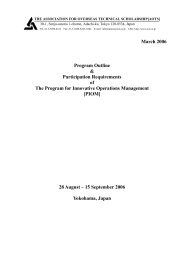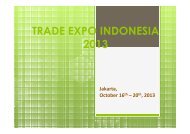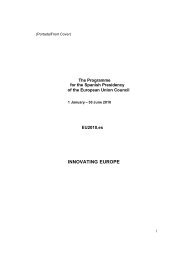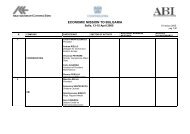Analysis of the Operation and Financial Condition of the Enterprise
Analysis of the Operation and Financial Condition of the Enterprise
Analysis of the Operation and Financial Condition of the Enterprise
You also want an ePaper? Increase the reach of your titles
YUMPU automatically turns print PDFs into web optimized ePapers that Google loves.
<strong>Analysis</strong> <strong>of</strong> <strong>the</strong> <strong>Operation</strong> <strong>and</strong> <strong>Financial</strong> <strong>Condition</strong> <strong>of</strong> <strong>the</strong> <strong>Enterprise</strong>A budget summarises all revenues <strong>and</strong> expenses <strong>of</strong> an enterprise <strong>and</strong> shows <strong>the</strong> amount<strong>of</strong> <strong>the</strong> expected pr<strong>of</strong>it.The cash flow forecast plays a very important role. This has to be projected after<strong>the</strong> budget is prepared as <strong>the</strong> amount <strong>of</strong> turnover that <strong>the</strong> enterprise plans to achieve isalready available. The amount <strong>of</strong> turnover is necessary for planning <strong>of</strong> <strong>the</strong> incoming cashflow. The asset turnover ratios can be <strong>of</strong> assistance here. As it is well known, cash <strong>and</strong>turnover is not <strong>the</strong> same thing. Therefore, when projecting cash inflows it is highlyimportant to most accurately plan <strong>the</strong> collection <strong>of</strong> accounts receivable. The policy forcollection <strong>of</strong> debtors’ debts in an enterprise is not insignificant here, however, as <strong>the</strong>enterprise upon planning <strong>of</strong> cash flows <strong>of</strong>ten takes historical data for <strong>the</strong> previous year intoaccount, <strong>the</strong> debtor's turnover ratio has to be estimated for an enterprise - this would allowdetermine <strong>the</strong> period closing balance figure <strong>of</strong> accounts receivable. After <strong>the</strong> figures for<strong>the</strong> period opening <strong>and</strong> closing debtors balance <strong>and</strong> <strong>the</strong> turnover have become known cashinflows from sales for <strong>the</strong> period can be estimated by ma<strong>the</strong>matical methods. One shouldalso bear in mind that <strong>the</strong> balances <strong>of</strong> <strong>the</strong> accounts receivable include VAT amounts, while<strong>the</strong> turnover doesn’t <strong>and</strong> <strong>the</strong>refore certain adjustments need to be made in calculations <strong>of</strong><strong>the</strong> cash inflows.While planning <strong>the</strong> outflow <strong>of</strong> cash all enterprise creditors are split into suppliers directlyselling <strong>the</strong>ir products, goods necessary for <strong>the</strong> provision <strong>of</strong> <strong>the</strong> enterprise businessactivities, <strong>and</strong> into suppliers delivering <strong>the</strong>ir services required to maintain its businessactivities. Therefore it becomes more underst<strong>and</strong>able which creditors should be paid by <strong>the</strong>enterprise in <strong>the</strong> current or in ano<strong>the</strong>r month. For example, <strong>the</strong> situation with <strong>the</strong> creditorsproviding services becomes clear - this outflow <strong>of</strong> cash can be planned based on historicaldata from <strong>the</strong> previous year, as <strong>the</strong> services received each month are <strong>the</strong> same, <strong>and</strong>,<strong>the</strong>refore, an enterprise can expect that it has to pay monthly for rent, electricity, transport,advertisement, loan interest as well as tax, salaries etc. The situation with <strong>the</strong> suppliers <strong>of</strong>goods is more complex. If <strong>the</strong> range <strong>of</strong> goods sold by an enterprise is very wide <strong>and</strong> it isnot possible to project, who <strong>and</strong> how much needs to be paid, because it depends on howwell <strong>and</strong> which br<strong>and</strong>s <strong>of</strong> goods will sell better, <strong>the</strong>n <strong>the</strong> turnover ratios can assist again.The first thing that needs to be done, when planning payments to suppliers <strong>of</strong>goods, is to plan <strong>the</strong> balances to be purchased <strong>and</strong> <strong>the</strong> amounts that would be available forsale. According to <strong>the</strong> budget prepared an enterprise already knows how much has beenplanned for production pr<strong>of</strong>itability in <strong>the</strong> enterprise <strong>and</strong>, <strong>the</strong>refore, it is also known, whatis <strong>the</strong> amount <strong>of</strong> <strong>the</strong> prime cost from <strong>the</strong> turnover. The prime cost <strong>of</strong> goods is exactly <strong>the</strong>value <strong>of</strong> goods sold in every particular month. With <strong>the</strong> prime cost <strong>of</strong> goods sold known<strong>and</strong> taking <strong>the</strong> historical data for <strong>the</strong> previous year as <strong>the</strong> basis, <strong>the</strong> stock turnover ratio isalso available; it can be estimated how much stock will remain at <strong>the</strong> end <strong>of</strong> <strong>the</strong> monthwhich will be <strong>the</strong> reference point in planning <strong>the</strong> cash flow fro <strong>the</strong> following month.Therefore, if <strong>the</strong> monthly opening stock balances, <strong>the</strong> amounts to be sold <strong>and</strong> <strong>the</strong> amountsremaining are available, it can be ma<strong>the</strong>matically estimated what will be <strong>the</strong> amount <strong>of</strong>goods to be purchased. Stock data are required to plan <strong>the</strong> movement <strong>of</strong> <strong>the</strong> accountspayable to <strong>the</strong> goods suppliers. There is an assumption made that creditors need to be paidas much as it is sold. This presupposes that <strong>the</strong> figure <strong>of</strong> <strong>the</strong> cost <strong>of</strong> goods sold is available,<strong>and</strong>, if we accept this assumption, <strong>the</strong>n it is only necessary to multiply this cost <strong>of</strong> goodswith <strong>the</strong> rate <strong>of</strong> VAT, <strong>and</strong> <strong>the</strong> amount <strong>of</strong> payment to creditors for each particular month is62
















